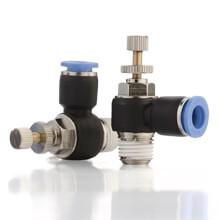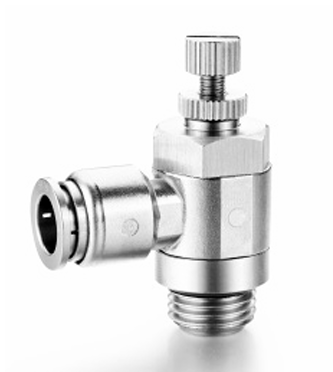Table of Contents
Toggle1. Introduction
In the dynamic realm of pharmaceutical manufacturing, the preparation of liquid dosage forms, commonly referred to as solution preparation, is a fundamental process that ensures the effective delivery of active pharmaceutical ingredients (APIs) to patients. Solutions are among the most preferred dosage forms due to their ease of administration, rapid absorption, and dosage flexibility. Given the critical nature of these preparations, it becomes imperative for manufacturers to utilize advanced technologies that enhance efficiency, accuracy, and compliance with stringent regulatory standards. One such technology that has revolutionized this sector is pneumatic equipment.

2. What are The Advantages of Pneumatic Equipment In Solution Preparation Pharmaceutical Manufacturing Process?
Pneumatic equipment plays a crucial role in the solution preparation process within pharmaceutical manufacturing. Utilizing compressed air for various functions, these systems incorporate components such as pneumatic conveyors, mixers, and filling machines. Below, we delve into the advantages of pneumatic solutions in detail:

Precise Control: Pneumatic systems provide precise control over the flow, pressure, and volume of fluids and gases used in the solution preparation process. This allows for tight control over the final product composition and quality.
Consistent Mixing: Pneumatic agitation and mixing systems can ensure thorough and consistent blending of solution components, leading to more homogeneous final products.
Reduced Contamination Risk: Pneumatic systems use compressed air or inert gases to move and mix solutions, minimizing the risk of microbial or particulate contamination compared to mechanical mixing methods.
Improved Safety: Pneumatic systems operate at lower temperatures and pressures compared to some alternative technologies, reducing the risk of equipment failure or operator injury.
Scalability: Pneumatic systems can be easily scaled up or down to accommodate changes in production volume, making them well-suited for pharmaceutical manufacturing where flexibility is important.
Reduced Maintenance: Pneumatic components generally have fewer moving parts and require less maintenance than electric or hydraulic systems, leading to lower operating costs.
Explosion-proof Design: Pneumatic systems can be designed to be explosion-proof, which is an important safety consideration for handling flammable or volatile solvents in pharmaceutical manufacturing.
3. Key Processes in Solution Preparation Manufacturing
In pharmaceutical manufacturing, solution preparation involves several critical processes, each designed to ensure the consistent production of high-quality liquid formulations. The integration of pneumatic equipment enhances the efficiency, precision, and compliance of these processes. Below is a detailed exploration of the key processes involved in solution preparation manufacturing:

a. Material Handling
Efficient material handling is the cornerstone of successful solution preparation. Timely and effective transport of raw materials is critical to maintaining production continuity. Pneumatic conveying systems play a vital role here, offering several advantages:
- Raw Material Transfer: Pneumatic conveying systems facilitate the rapid and efficient transfer of active pharmaceutical ingredients (APIs) and excipients from storage areas to mixing and processing stations. By utilizing compressed air, these systems transport solid and liquid materials seamlessly through dedicated pipelines, minimizing human intervention and significantly reducing handling times. This rapid transfer helps mitigate delays that could disrupt the overall manufacturing timeline and ensures a consistent supply of materials throughout the manufacturing cycle.
- Versatility in Transfer: Pneumatic systems can handle various material states, including powders, granules, and liquids, providing flexibility in processing different formulations. Whether it’s transporting delicate APIs or bulk excipients, pneumatic systems can be tailored to meet the specific requirements of each ingredient, enhancing operational efficiency.
b. Mixing and Dissolution
The mixing and dissolution of ingredients are pivotal to creating a stable and effective final product. Effective mixing ensures that all components are blended uniformly, resulting in a homogenous solution crucial for consistent drug release and absorption.
- Pneumatic Mixers: Advanced pneumatic mixers utilize controlled airflow alongside mechanical agitation to achieve uniform blending of ingredients. These mixers are designed to operate under specific conditions, such as temperature, pressure, and humidity, which can significantly affect the final product’s characteristics. By optimizing these parameters, pneumatic mixers ensure that every batch meets quality specifications, maintaining drug efficacy and safety.
- Controlled Dissolution: The dissolution process is equally important, as it affects the solubility and bioavailability of APIs. Pneumatic mixers provide controlled environments that promote thorough dissolution, allowing solvents to effectively interact with solid particles. This precision helps prevent agglomeration and ensures that all particles are fully dissolved, resulting in solutions with predictable pharmacokinetic profiles.
c. Filtration
Filtration is a vital step that eliminates impurities, particulates, and contaminants from the final solution. The effectiveness of the filtration process directly impacts the quality of the product, making it a crucial stage in solution preparation.
- Pneumatic Filtration Systems: These systems utilize air pressure to facilitate efficient filtration. By applying pneumatic pressure, the systems enhance the flow of liquids through filtration membranes or media, which can capture impurities and ensure that only clean, compliant fluid is captured for further processing or packaging. Pneumatic filtration systems can be tailored with various filter types—such as depth filters, membrane filters, or activated carbon filters—depending on the specific requirements of the solution being processed.
- Automated Monitoring: Modern pneumatic filtration systems often incorporate real-time monitoring technologies that track critical parameters such as flow rate, pressure differentials, and filter integrity. Continuous monitoring supports proactive maintenance, ensuring filters remain effective and reducing the risk of contamination due to filter failures.
d. Filling and Packaging
The accuracy of the filling process is critical for maintaining dosage accuracy in liquid preparations. Variability in filling volumes can lead to dosing errors, impacting patient safety and regulatory compliance.

- Pneumatic Filling Machines: Utilizing pneumatic technology, these filling systems offer precise control over filling volumes, ensuring consistent and repeatable performance. Pneumatic filling machines utilize techniques such as positive displacement or gravity-assisted filling, which allow for accurate measurements that meet stringent pharmaceutical standards.
- Enhanced Automation: Advanced pneumatic filling machines can be integrated with automated controls and sensors that facilitate real-time adjustments during the filling process. This level of automation minimizes human error, enhances operational efficiency, and assures compliance with industry regulations. The ability to dynamically adjust filling volumes also allows for adaptability to various container sizes and formulations, increasing flexibility in production runs.
- Seamless Integration with Packaging: Pneumatic filling machines can be seamlessly integrated with downstream packaging operations, ensuring a smooth transition from filling to capping or labeling. This integration reduces the handling of filled containers, minimizing contamination risks and optimizing workflow efficiency. Additionally, automated packaging lines equipped with pneumatic systems ensure consistent sealing and labeling, further enhancing quality assurance.
4. Quality Control and Compliance
Quality control is non-negotiable in the pharmaceutical industry, where stringent regulatory requirements govern the manufacture of medicinal products. Compliance with these regulations is essential to ensure patient safety and product efficacy.
- Support for Compliance: The implementation of pneumatic equipment enables manufacturers to achieve reliable tracking and monitoring of critical parameters throughout the production process. For instance, pneumatic systems can incorporate data logging capabilities that continuously capture information on flow rates, pressures, temperatures, and filling volumes. This data is essential for regulatory audits and product consistency reports, ensuring that all operations adhere to industry standards such as FDA regulations and Good Manufacturing Practices (GMP).
- Validation and Documentation: Pneumatic systems can be designed to facilitate easier validation processes by maintaining stringent records of operational parameters and changes. This is crucial for demonstrating compliance during regulatory inspections. Automation in logging procedures not only streamlines documentation but also enhances traceability, allowing for quick identification of any deviations that may occur during manufacturing.
- Routine Quality Checks: Integration of pneumatic systems allows for routine quality checks during various stages of solution preparation. For example, inline monitoring systems can be incorporated to evaluate the parameters of the final product, such as pH, viscosity, and clarity, thereby ensuring that all outputs meet the requisite specifications before packaging. By embedding quality checks directly into the production line, manufacturers can swiftly address any issues, thereby maintaining high standards of quality and safety.
5. Applicable Products
A.Composite push to connect to fittings(PTC)
PTC fittings are also called push in fittings, one touch fittings. They are-
- Ability to work in vacuum, compress air
- Hygienic design with environmentally-friendly materials, past Rohs certification
- Lightweight & Compact, save installation space
- Cost-effective; affordable price
Specifications
- Applicable Fluid Type : Air, Water(No Drinking Water/Hot water)
- Working Pressure Range: -14~150 PSI; -0.99~9.9Kgf/m²(‘-99~990Kpa)
- Negative Pressure: -29.5 in Hg(-14PSI); -750mmHg(-750Torr)
- Working Temperature Range: 23~140 ℉ (Air); 32~104 ℉ (Water); -5~60℃ (Air); 0~40℃ (Water)
- Recommanded Tubings: PA11, PA12, PA6, PE, PU,FEP,PFA
Features:
- Stainless steel gripping ring
- High performance PBT & Resin brass body
- NBR U-packing; silicon free
- NPT, BSPT, BSPP, metric threads & plug-in options
- Widest range of configurations
- Round internal hex on straights allows for easy assembly in tight areas

B. All Brass Nickel Plated Push fittings
Specification
- Applicable Fluid Type Air, Water(No Drinking Water),Vacuum
- Working Pressure Range-14 ~225 PSI-0.99~15Bar
- Working Temperature Range-4 ℉ ~160 ℉-15℃ ~71℃
- Vacuum Rating to 28”Hg
- Recommanded Tubings PA11, PA12, PA6, PE, PU,FEP,PFA
Features
- Ability to work in compress air
- Hygienic design with environmentally-friendly materials, past Rohs certification
- Lightweight & Compact, save installation space
- High performance
- FKM seal for chemical and high application

C. 316L Stainless Steel Push in Fittings
Specification
- Applicable Fluid Type: Air, Water,Vacuum
- Working Pressure Range: -14 ~225 PSI; -0.99~ 15 Bar
- Working Temperature Range: 5 ℉ ~428 ℉; -15℃ ~220℃
- Vacuum Rating: to 750mmHg
- Recommanded Tubings: PA11, PA12, PA6, PE, PU,PTFE,FEP
Features
- Food grade material can contact food directly
- Withstand high temperature and resistance to chemicals
- Lightweight and compact
- Smooth appearance design is easy cleaning
- Very fast delivery

D. Pneumatic Flow Control Valve
- Composite, brass and 316L stainless steel materials
- Adjustment screw available, can control the flow very well
- Control the speed of pneumatic air cylinder
- Compact size can save the installation space
- 316L stainless steel material can use for high temprature filling machine etc.



E. Pneumatic Tubes
- PU tube, PE tube, Nylon tube, FEP tube for choice
- Working temperature: -40°C to + 70°C
- Working pressure: -0.99 to +10 bar
- Applicable Fluid type: Air, Water
- Flexible, lightweight, wear-resisting, low degree bending radius
- Better for pneumatic control
- Economical cost with different types
- Compatible with our push in fittings, barbed fittings


